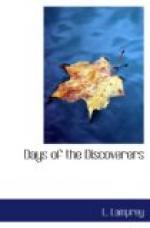“There was a colony of Captain George Popham and Ralegh Gilbert went out, five year ago,” said Simons doubtfully. “They said they could not endure the bitter climate.”
“Sho,” said Smith impatiently, one stubbed forefinger on the map, “’t is in almost the same latitude as France. Maybe they chose the wrong place for their plantation. Why, the French trade furs with the savages, all up and down the Saint Laurence, and mind the cold no more than nothing at all. The first thing we know, the Dutch will be out here finding a road to the Indies.”
Both men laughed. They had lost faith in that road to fortune.
“Anyhow Hudson didn’t find it when they sent him to look for it the year afore he died,” said Simons, “or they’d be into it now. But what are you scheming?”
“First make a voyage of exploration,” said Smith. “I ha’ talked with one and another that told me they taken a draught of the coast, and I ha’ six or seven of the plots they drew, so different from one another and out of proportion they do me as much good as so much waste paper—though they cost me more,” added the veteran grimly. “With a true map o’ the coast, we’d know whereabouts we were.”
“No gold nor silver, I hear.”
“Maybe not. But what commodity in England decays faster than wood? And where will you find better forest than along that shore? Build shipyards there, and our English folk would make a living off’n that and the fisheries. I know how ’t was in Boston—the Flemings would salt their fish down right aboard the ships when the fleets came in. But men for work like this must be men—not tyrants, nor slaves.”
John Smith’s eyes flashed, and his lips closed so tightly that his thick mustaches and beard stuck straight out like a lion’s. He had seen a plenty of both slavery and tyranny in his life.
In fact there was a neck-and-neck race between the Plymouth Company and the Dutch West India Company, for the control of the northern province. Dutch fur traders were already on Manhattan Island living in makeshift wooden huts, and Adrian Block was exploring Long Island Sound, when John Smith went out to map the coast north of Cape Cod for Sir Ferdinando Gorges of the Plymouth Company in 1614. The two little English ships reached the part of the coast called by the Indians Monhegan in April of that year. They had general instructions to meet the cost of the expedition, if possible, by whaling, fishing and fur-trading. No true whales were found, however, and by the time the ships reached the fishing grounds the cod season was nearly past. Mullet and sturgeon were plentiful in summer, and while the sailors fished, Smith took a few men in a small boat and ranged the coast, trading for furs. Within a distance of fifty or sixty miles they got in exchange for such trifles as were prized by the Indians, more than a thousand beaver skins, a hundred or more martens and as many otter-pelts.




